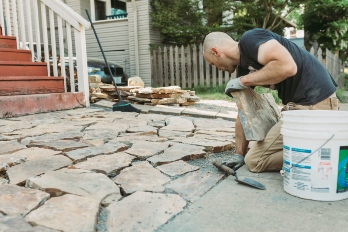Does your home need important repairs and improvements? And it’s just not in the budget? You’re not alone. It’s a common problem, especially for new homeowners.
The good news is that lots of grants and no- or low-interest loans help homeowners pay for repairs, critical improvements, and energy-saving upgrades.
Things like replacing your roof, fixing your boiler, removing lead paint, or insulating. Or making your home handicap accessible.
Please, don’t be shy about using these programs. It’s about protecting your investment in your home.
So don’t reach for your credit card or go for a regular bank loan just yet.
Let’s take a broad look at home assistance programs and how they work, including:
- Grants that you don’t have to pay back
- Loans with no or very low interest
- Income caps — often more relaxed than you’d guess
Grants that you don’t pay back
Home repair and improvement grants are often earmarked for health and safety issues or emergencies. Most are given out by the federal, state, or city government. Some nonprofit organizations offer them too.
A grant might cover all or just part of a project. Either way, it doesn’t have to be paid back, as long as you meet the requirements of the particular grant.
Common grant requirements:
- Income caps; you’ll submit financial documents
- A formal estimate from one or more contractors
- You might have to use a contractor chosen by the program
- You must continue to own your home for a certain number of years
- Some cover only specific types of projects, such as lead removal or energy upgrades
- Some are just for families with children
- Some are just for people with disabilities
- Some target certain locations, such as rural or urban
TIP: Be first in line for federal grants
Federal grants are in high demand. And the city and county agencies that manage them often start their fiscal year on July 1 — double-check with your local agencies. Get your application in at the start of the fiscal year, before funds run out.
Loans at no or low interest
It might be hard to think about taking on another loan. With a no- or low-interest home repair and improvement loan, though, borrowing is cheap. And you can fix your home now — before problems get worse.
Most of these loans are funded by the federal, state, county, or local government. You might get one directly from the government or through a local bank branch.
One of the most widespread types is made at the county level: the “HIP” (Home Improvement Program) loan. The interest rate is always lower than on a typical bank loan, and much lower than on a credit card. The county or a local bank partner makes the loan, with the county subsidizing all or part of the interest.
Common loan requirements:
- Income caps; you’ll submit financial documents
- Your home must be valued below a certain limit
- Program staff monitor the project
- Your taxes must be paid in full
- You can’t pay off other loans with the money
- You can’t use the money to pay for projects you already started
- You must finish the project within a certain time frame, such as one year
- No luxury projects
TIP: Keep your paperwork organized
Grants and loans often require several steps along the way. Keep paperwork, contracts, and receipts in one place. And keep copies of everything you submit.
Income caps
Many grant and loan programs require that your household income be less than a certain amount. If you think your income is too high, you might be wrong!
Income caps are often higher than you’d think. That’s partly because housing costs eat up a big chunk of the household budget in many places. Some programs take that into account.
You might qualify even if your income is over the cap at first glance. Sometimes the cap shifts based on your situation. For example, some programs adjust it for family size.
Because there are so many variables, go ahead and apply unless your income is way over the limit.
How caps are set
Roughly speaking, it often depends on three things:
- Your income. Different programs calculate it differently. Some might use your adjusted gross income from the previous year’s taxes. Others might use your current pay stub.
- Your area’s median family income. As determined by the US Department of Housing and Urban Development. Curious? Go to HUDuser.gov and search for “income limits.”
- The max allowable income. It’s usually a percentage of the area median family income. It might be anywhere from 30% to 120% or more.
Let’s say your area’s median income is $70,000 — around the national average. Here’s what several caps could look like.
- 30% cap = income under $21,000
- 50% cap = income under $35,000
- 80% cap = income under $56,000
- 120% cap = income under $84,000




